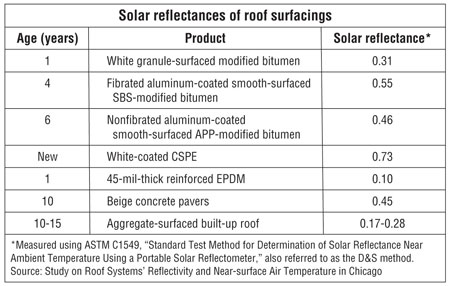Surfacings can serve one or more functions for low-slope membrane roof systems. Surfacings' primary purpose is to protect membrane roof systems from the effects of ultraviolet rays and weather exposure. However, surfacings also can provide increased fire resistance and impact resistance, aesthetic enhancement and improved roof system thermal performance.
Surfacings can be an integral factory-applied element of a membrane or a separate field-applied component of a roof system. Membrane surfacings come in various forms, including aggregate, ballast, mineral granules, liquid-applied coatings, metal foils, green roof overburden and an occasional combination. Factory-surfaced membranes include metal foils, mineral granules, coatings and granule-coating combinations. Field-applied surfacings include aggregate, ballast, mineral granules, coatings and green roof overburden.
Aggregate is used to surface built-up and polymer-modified bitumen roof systems. When used in this context, aggregate is embedded on a roof surface using hot bitumen or—less frequently—cold mastic. Aggregate generally is 3/8 to 3/4 of an inch in diameter river gravel, crushed stone or slag. Gravel and crushed stone, such as Merrimac gravel, marble chips, geo rock and green garnet, may be used for decorative purposes. Mineral granules also can be broadcast into mastic as a field-applied surfacing.
Ballast also is used to surface loose-laid, ballasted single-ply roof systems and protected membrane roof systems. Ballast generally is 1 to 2 1/2 inches in diameter aggregate, as differentiated from built-up roof aggregate, or concrete roof pavers. Ballast also can be used for decorative purposes and designed to provide or enhance a roof system's wind-uplift resistance.
Liquid-applied coatings applied in the field are available in a wide variety of formulations for use on various substrates and to achieve certain desired properties. Solvent- and water-based compounds may be characterized as bituminous-based, aluminum-pigmented, elastomeric or hybrid elastomeric. The wide range of coating compositions and their intended uses are more thoroughly discussed in The NRCA Guide to Roof Coatings and on the Roof Coatings Manufacturers Association's Web site, www.roofcoatings.org. Also, for more information about roof coating technology, see "Selecting correct coatings—part 1," page 32.
Green roof system surfacings consist of overburden (growing medium, plantings, landscaping and decorative elements) on top of a waterproof substrate. The NRCA Green Roof Systems Manual—2007 Edition provides additional information.
A common element of all roof surfacings is solar reflectance—the fraction of solar radiation reflected away from a surface expressed as a value in the range of 0.00 to 1.00. Some examples of solar reflectances are noted in the figure.

Examples of roof surfacings' solar reflectances
Current emphasis on energy efficiency and conservation has led to some energy codes specifically recommending and, in some cases, requiring the use of roof surfacing materials with minimum solar reflectance values. Roof surfacing options should be evaluated carefully to best achieve roof systems' service life expectations and maximize energy efficiency for specific geographic locations.
Tom Bollnow is NRCA's senior director of technical services.

